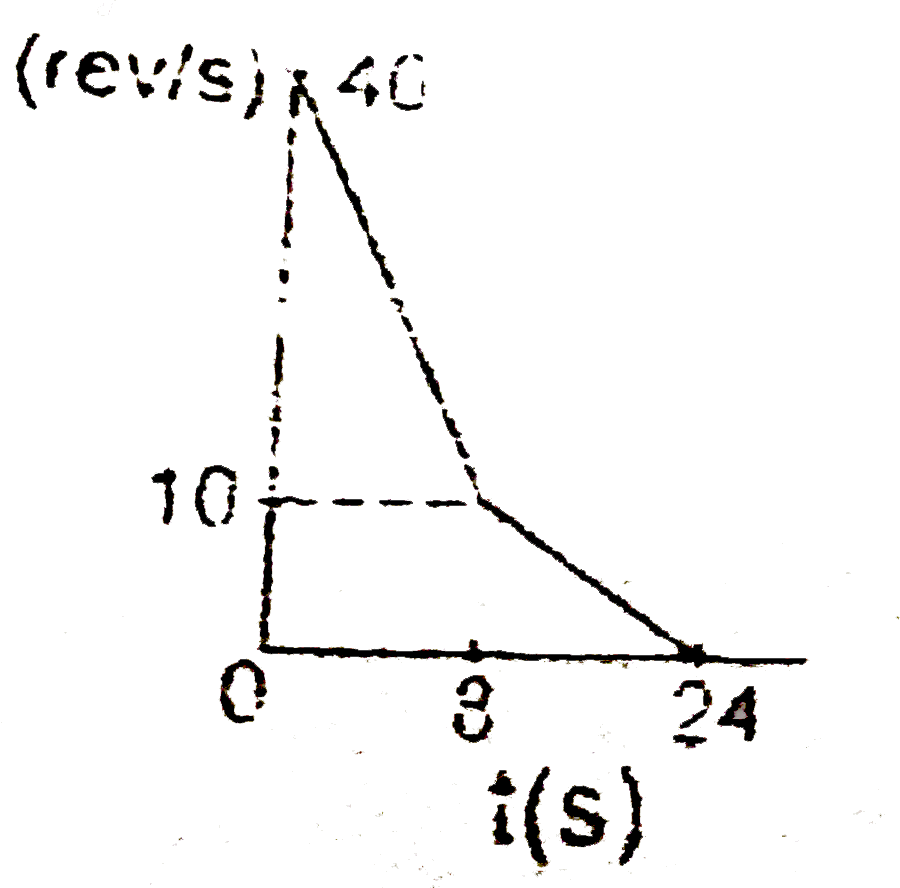A table fan, rotating at a speed of 2400 rpm, is switched off and the resulting variation of the rpm with time is shown in the figure. The total number of revolutions of the fan before it comes to rest is

420
280
190
16800
The correct Answer is:B
The corresponding (Rev/sec) graph is (Rev/sec)

Area under this curve gives the total number revolutions
Δ=12(8)(30)+(10×8)+(16)(10)
= 280 revolutions
D is only correct option
Topper's Solved these Questions
- DAILY PRACTICE PROBLEMBOOK - RESONANCE ENGLISHCHAPTER - DAILY PRACTICE PROBLEMEXERCISE - DPP No.30
9 Videos
- DAILY PRACTICE PROBLEMBOOK - RESONANCE ENGLISHCHAPTER - DAILY PRACTICE PROBLEMEXERCISE - DPP No.31
20 Videos
- DAILY PRACTICE PROBLEMBOOK - RESONANCE ENGLISHCHAPTER - DAILY PRACTICE PROBLEMEXERCISE - DPP No.28
9 Videos
- CURRENT ELECTRICITYBOOK - RESONANCE ENGLISHCHAPTER - CURRENT ELECTRICITYEXERCISE - High Level Problems (HIP)
19 Videos
- ELECTRO MAGNETIC WAVESBOOK - RESONANCE ENGLISHCHAPTER - ELECTRO MAGNETIC WAVESEXERCISE - Exercise 3
27 Videos
Similar Questions
A fan is rotating with a speed of 450 rec/minute. After being switched off it comes to rest in 10s. Assuming constant angular deceleration, calculate the number of revolutions made by it before coming to rest.
View SolutionThe speed of a motor decreases from 1200 rpm to 600 rpm in 20s. The total number of rotations it makes before coming to rest is
View SolutionA fan makes 2400 rpm. If after it is switched off, it comes to rest in 10 s, then find the number of times it will rotate before it comes to rest after it is switched off.
View SolutionA fan is rotating with angular velocity 100revs−1. Then is switched off. It takes 5minto stop.
(a) Find the total number of revolution made before the fan stops. (assume uniform angular retardation).
(b) Find the value of angular retardation.
( c) Find the average angular velocity during this interval.
View SolutionA flywheel is rotating at the rate of 100 rpm and slows down at a constant rate of 1 rad/s2. Calculate the time required to stop the flywheel and the number of rotations made by the flywheel before coming to rest?
View SolutionA wheel of mass 10 kg and radius 0.2 m is rotating at an angular speed of 100 rpm, when the motion is turned off. Neglecting the friction at the axis. Calculate the force that must be applied tangentially to the wheel to bring it to rest in 10 rev. Assumed wheel to be a disc.
View SolutionA wheel of mass 10 kg and radius 0.2 m is rotating at an angular speed of 100 rpm, when the motion is turned off. Neglecting the friction at the axis. Calculate the force that must be applied tangentially to the wheel to bring it to rest in 10 rev. Assumed wheel to be a disc.
View SolutionA disc of mass M kg and radius R metre is rotating at an angular speed of ω rad/s when the motor is switched off. Neglecting the friction at the axie, the force that must be applied tangentially to the wheel to bring it to rest time t is
View SolutionA ceiling fan rotates about its own axis with some angular velocity. When the fan is switched off, the angular velocity becomes (14)th of the original in time 't' and 'n' revolutions are made in that time. The number of revolutions made by the fan during the time interval between switch of and rest are (Angular retardation is uniform)
View SolutionA shaft initially rotating at 1725 rpm is brought to rest uniformly in 20s. The number of revolutions that the shaft will make during this time is
View Solution
